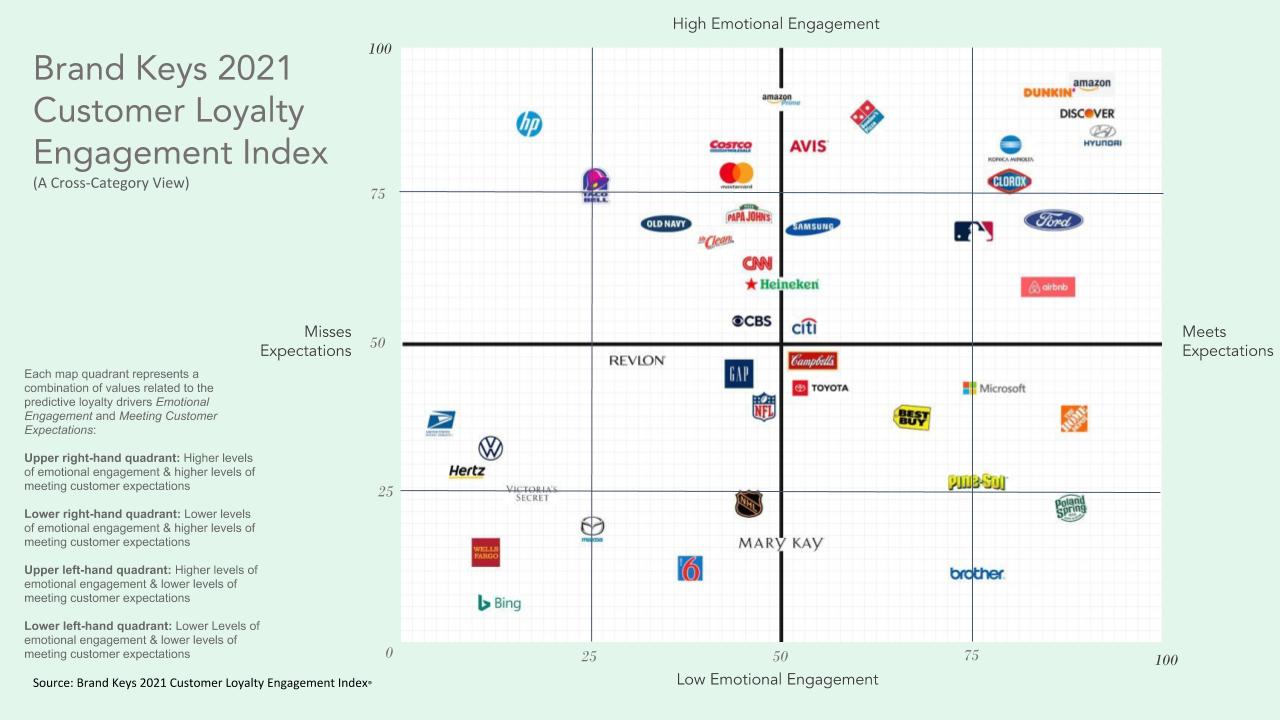
Despite what some marketing pundits claim, customer loyalty has survived the impact of the COVID-19 pandemic. And, no surprise, loyalty has changed dramatically since 1996, when Brand Keys released its first Customer Loyalty Engagement Index. Now, its 25th annual survey (2021) found that brands in all key categories have faced two severe stress tests.
- How to enhance brand-to-consumer emotional engagement (the result of effective marketing that increases brand equity, resulting in customers behaving more positively toward the brand);
- How to leverage brand values to best meet customers’ expectations, which is a key dimension of customers’ brand belief-systems. They want what they want and those wants are unconstrained by reality – or a global pandemic.
Customer expectations increase on average by 22 percent a year, but typically most brands manage to gain only seven percent annually, which creates an ever-growing gap between customer desires and brand promises. That gap can be an opportunity or an obstruction for brands. It’s dependent upon how well brands are able to pass those loyalty stress tests.
This year, to graphically illustrate brand loyalty rankings, the report shows a series of emotional engagement/expectation maps to visually delineate brand loyalty positions in the marketplace, based on stress-test dynamics and identify paths-to-loyalty.
Each quadrant on the map represents a combination of values related to predictive loyalty drivers – emotional engagement and meeting customer expectations:
- Upper right-hand quadrant: Higher levels of emotional engagement & higher levels of meeting customer expectations;
- Lower right-hand quadrant: Lower levels of emotional engagement & higher levels of meeting customer expectations;
- Upper left-hand quadrant: Higher levels of emotional engagement & lower levels of meeting customer expectations;
- Lower left-hand quadrant: Lower Levels of emotional engagement & lower levels of meeting customer expectations.
To guarantee loyalty, marketers ideally want consumers to feel that their brand engenders a high level of emotional engagement, as well as meeting their expectations as completely as possible. Brands that succeed are six times more likely to create loyal customers.
All sectors faced challenges to customer loyalty and brands were faced a steep learning curve in how to communicate with homebound, frightened consumers.
It’s estimated that consumers who were unable to leave their homes spent an average of seven hours a day in front of a screen of one sort or another. People watched streaming services, such as Netflix, Amazon Prime, and Disney+. Eventually binging got old, but there was always the news. Fox News, CNN, and MSNBC all grew audiences significantly – up a collective 46 percent year over year.
In sports, the NBA, NFL, NHL, and MLB all suffered viewership declines as rescheduled seasons got squeezed into the second half of 2020 and league brands competed for eyeballs.
In the wake of the coronavirus and resulting economic crisis, retail closings and re-openings, and learning how to adapt to health-and-safety regulations, while still meeting increased customer expectations, all added additional stress. Retailers who were the first to recognize (and meet) these pandemic-fueled expectations secured additional customer loyalty.
For the nation’s restaurant industry – neighborhood diners and national chains – the pandemic completely altered consumer behavior, from how people order restaurant food to where they can eat to their perceptions of third-party delivery companies. Loyalty has been more critical than ever in this sector.
When the pandemic hit, the first thoughts of airlines and hotels were to rebook and re-schedule, which didn’t meet customer expectations. Airlines eventually gave full refunds or allowed bookings two up to three years ahead, and upgraded technology to reduce face-to-face contact. Hotels upgraded cleaning regimens significantly, including providing personal hand sanitizer and mandating mask requirements. Those that engaged customers and met their ever-increasing expectations saw loyalty grow.
It turns out that, during disasters, consumers will compromise, but they still continue to demand their expectations be met.
Finally, throughout the coronavirus pandemic, liquor stores (and pizza purveyors) were the only type of business that seems to have seen an increase in activity, although they too faced the same obstacles as retailers in general. As for alcoholic beverages, customer loyalty to particular brands was preeminent during the pandemic.
Desperate times called for desperate choices due to a lack of product availability. Purchase of “new” or “alternative” brands represented a basic need, not a lack of customer loyalty. It turns out that, during disasters, consumers will compromise, but they still continue to demand their expectations be met.
The lack of product availability or supply-chain breakdowns do not denote the disappearance of brand loyalty. Being in-stock matters as regards sales, but loyal customers are more likely to stick with their favorite brands through difficult times and, in a more stable marketplace, will wait for them or actively seek them out.
The 2021 Customer Loyalty Engagement Index confirms that brands that best meet consumers’ expectations, and are capable of sustaining emotionally engaging relationships, will always see enhanced loyalty.
The survey included 855 brands in 94 categories and involved 75,804 consumers, 16 to 65 years of age from the nine US Census Regions, who self-selected categories in which they are consumers and brands for which they are a customer.
Cover image source: Lukas Blazek
